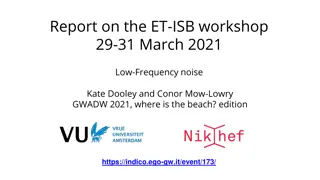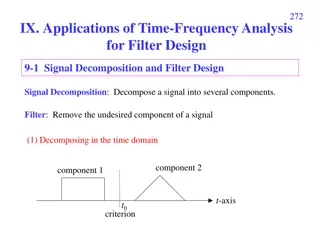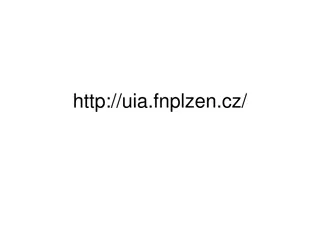Understanding Immunodeficiencies: Classification, Frequency, and Types
Basic immunological terms explain the functions of the immune system, including defense against infection, homeostasis, and immunological surveillance. Immunodeficiencies are disorders of the immune system that impair its ability to carry out these functions. They can be classified into humoral, cellular, primary hereditary, and secondary acquired types. The European Registry of Primary Immunodeficiencies shows the prevalence of various disorders, such as antibody deficiencies and T cell deficiencies. In the Czech Republic, primary immunodeficiency types like X-linked agammaglobulinemia, CVID, and SCID have been identified with their respective frequencies.
Download Presentation

Please find below an Image/Link to download the presentation.
The content on the website is provided AS IS for your information and personal use only. It may not be sold, licensed, or shared on other websites without obtaining consent from the author. Download presentation by click this link. If you encounter any issues during the download, it is possible that the publisher has removed the file from their server.
E N D
Presentation Transcript
Immunodeficiencies, part 1 Martin Li ka
Basic immunological terms Immune system provides 3 basic functions: a) Defense against infection b) Homeostasis elimination of old or impaired cells c) Immunological surveillance - elimination of mutated cells Endocrine system Immune system Nervous system Disorders detectable by laboratory or histological methods, without clinical manifestation Clinical manifestation decreased function - immunodeficiencies - increased function allergy, autoimmunity
Immunodeficiency = a disorder of immune system which manifests by impaired ability to carry out basic immunological functions, primarily defence against infection or immunological surveillance
Classification of immunodeficiencies: Humoral nonspecific immune system complement system specific immune system immunoglobulins (B cells) Cellular nonspecific phagocytes specific T cells Primary hereditary, symptoms manifest mostly in early stages Secondary acquired, symptoms manifest mostly in any stages of life variable etiology (metabolic diseases, malignancies, immunosupressants, infections, stress etc.)
European registry of primary immunodeficiencies from 2003 (prevalence 1,52/100000) Disorder Frequency (%) Antibody deficiencies 66,3 T cell deficiencies + combined 17,6 Defects of phagocytes 7,4 Complement system defects 6,2 Other primary immunodeficiencies 2,5
Various types of primary immunodeficiency in Czech Republic (2003) Primary immunodeficiency X-linked agamaglobulinaemia CVID HyperIgM syndrome Selective IgA-deficiency Selective deficiency of IgG subclasses SCID DiGeorge syndrome Wiskott-Aldrich syndrome Hereditary angioedema C2 deficiencey C4 deficiency LAD I CGD HyperIgE syndrome Chronic mucocutaneous candidiasis X-linked lymphoproliferative syndrome Frequency (%) 3,9 19,6 0,8 51,2 2,4 1,5 4,6 0,5 10,6 0,4 0,5 0,2 1,8 1,2 0,4 0,4
Phenotypic classification of primary immunodeficiencies (PID) Immunodeficiencies affecting cellular and humoral immunity (Severe Combined ImmunoDeficiency, HyperIgM Syndrome) Combined immunodeficiency with associated or syndromic features (diGeorge Syndrome, ataxia teleangiectasia (ATM), Nijmegen breakage sy., Wiskott-Aldrich Syndrome (WAS), HyperIgE Syndrome(HIES), NEMO def.) Predominantly antibody immunodeficiencies (X-Linked Agammaglobulinaemia (XLA), Common Variable ImmunoDeficiency (CVID), Transient Hypogammaglobulinaemia of Infancy (THI), Selective IgA Deficiency (SIAD), IgG subclasses def.)
Phenotypic classification of primary immunodeficiencies (PID) Diseases of immune dysregulation (Chediak-Higashi sy., X-linked LymphoProliferative Disease (XLP), Autoimmune LymphoProliferative Syndrome (ALPS), Autoimmune PolyEndocrinopathy with Candidiasis and Ectodermal Dystrophy (APECED), IL-10 def.) Congenital defects of phagocyte number, function, or both (Severe Congenital Neutropenia, Cyclic Neutropenia, Kostmann Syndrome, Leukocyte Adhesion Deficiency (LAD) syndrome I-III, Chronic Granulomatous Disease (CGD))
Phenotypic classification of primary immunodeficiencies (PID) Defects of intrinsic and innate immunity (IRAK4 def., MyD88 def., WHIM sy., Chronic Mucocutaneous Candidiasis (CMC)) Auto-inflammatory disorders (Familial Mediterranean Fevere (FMF), HyperIgD Syndrome (HIDS), Muckle-Wells syndrome, CINCA syndrome, Familial Cold Autoinflammatory Syndrome, TRAPS syndrome, BLAU syndrome)
Typical age of immunodeficiency manifestation Early infancy - severe combined primary immunodeficiencies 6 months 2 years severe hereditary antibody deficiencies 3 - 5 years transitory or selective antibody deficiencies, secondary immunodeficiencies 15 20 years hormonal instability, thymus involution, lifestyle changes, some typical infections (EBV), first symptoms of CVID Middleage excessive workload, stress, CVID, autoimmune disease, malignancies Advanced/old age rather symptoms of secondary immunodeficiencies
Immunodeficiency the main clinical features Antibody d. - recurrent microbial infections (capsulated bacteria) respiratory - pneumonia, sinusitis, otitis GIT diarrhea Complement system d. microbial infections (pyogenic), sepsis immunocomplex diseases (SLE) swellings in HAE C1-inhibitor deficiency Combined T cells (+ B cells) d. - bacterial, fungal, viral infections GIT symptoms diarrhea respiratory infections pneumonia, sinusitis Phagocytes d.- abscesses, recurrent pyogenic infections of skin, granulomatous inflammation
Immunodeficiency diagnosis History Laboratory tests: - blood cell count, Ig - FCM - special tests (lymphocyte functional tests, phagocytosis, respiratory burst test, IgG subclasses, specific Ig) Genetics
10 warning signs of primary immunodeficiency disorder (PID) Recurrent deep skin or organ abscesses Persistent thrush in mouth or fungal infection on skin Need for intravenous antibiotics to clear infections 2 deep-seated infections including septicemia A family history of PID 4 new ear infections within 1 year 2 serious sinus infections within 1 year 2 months on antibiotics with little effect 2 pneumonias within 1 year Failure of an infant to gain weight or grow normally
Therapy of immunodeficiency Severe PIDs HSCT Other PIDs gene therapy Primary & secondary IDs substitution (IVIG) prophylaxis (ATB) Mild IDs immunomodulation
I. Defects of phagocytes 1/ Quantitative defects of phagocytes a/ neutropenia, granulocytopenia severe congenital neutropenia (Kostmann sy.) cyclic neutropenia reticular dysgenesis sy.
I. Defects of phagocytes 2/ Qualitative defects of phagocytes - impaired ability of phagocytes to phagocyte or kill ingested microbes a/ Chronic Granulomatous Disease (CGD) X-linked (60%), event.AR defect of NADPH oxidase system impaired ability to produce toxic oxygen metabolites (e.g.H2O2) decreased ability to kill microbes (especially producing catalase: Staph.aureus or Pseudomonas aeruginosa) Symptoms: onset at early age formation of granulomas and abscesses in skin and organs Dg: respiratory burst test (FCM, NBTT) genetic tests Th: ATB prophylaxis in more severe cases BMT or gene therapy
I. Defects of phagocytes b/ Glucose-6-phosphate dehydrogenase deficiency similar symptoms like previous + hemolytic anemia c/ Myeloperoxidase deficiency susceptibility to infections caused by Staph.aureus or Candida albicans d/ Ch diak-Higashi syndrome recurrent severe pyogenic infections (streptococci, staphylococcci) neutrophils contain giant lysosomes (disorder of their content release impaired killing of microbes) Dg: neutrophils with abnormal chemotaxis and killing Th: ATB, ev.BMT
I. Defects of phagocytes e/ adhesion deficiency (LAD syndrome) defects of neutrophil adhesion molecules expression LAD I defect of integrins expression LAD II defect of selectins expression Clin.sympt.: recurrent skin and mucous infections, impaired healing of umbilical cord scar, formation of abscesses (especially in periproctal region) with poor production of pus Dg: proof of decreased CR3 expression Th: ATB, transfusion of donor granulocytes only treatment is BMT
II. Defects of complement system a/ C1, C2, C3, C4 deficiency Increased development of systemic immunocomplex diseases (SLE-like), susceptibility to pyogenic infections b/ C6, C7, C8, C9 deficiency Susceptibility to pyogenic infections, in C9 deficiency meningococcal infections c/ MBL deficiency MannanBinding Lectin deficiency (lectin pathway of complement system activation), increased frequency of common infections
II. Defects of complement system d/ Hereditary angioedema (HAE) absence or functional defect of C1 inhibitor C1-inhibitor = regulation of complement system, kinin and hemocoagulation cascade in case of C1-INH deficiency: dysregulation of bradykinin metabolism swellings Symptoms: recurrent swellings of skin, mucous membranes of larynx, gut (mimicking intestinal obstruction) onset mostly in adolescence triggering factor most frequently injury, surgery (e.g.dental), intercurrent infection Laryngeal swelling could be life-threatening without rescue therapy
II. Defects of complement system d/ Hereditary angioedema (HAE) Dg: C1-inhibitor concentration assessment C4 concentration assessment functional test of C1-inhibitor genetics Th: preventive androgens (Danazol), antifibrinolytics (tranexamic acid), C1-inhibitor concentrate rescue administration of C1 inhibitor concentrate (Berinert), selective bradykinin-receptor inhibitor (icatibant Firazyr), recombinant C1-inhibitor (Ruconest) Angioedema can be secondary too
III. Predominantly antibody immunodeficiencies X-linked (Bruton s) agammaglobulinemia (XLA) Mutation of Bruton s tyrosinkinase gene (Btk)(Xq21.3-22) block of maturation of pre-B cell into B cell severely decreased Ig levels and B cell numbers Most common X-linked form, but rarely forms affecting girls Symptoms: onset between 6thmonth and 2ndyear of age: recurrent pneumonias, pyogenic otitis, sinusitis with complications increased risk of pulmonary fibrosis Dg: IgG, IgA, IgM levels 2* SD of age mean absence of isohemaggulutinins and/or poor seroconversion to vaccination B cell numbers markedly decreased or absent genetic tests Th: life-long Ig replacement (SCIG, IVIG)
III. Predominantly antibody immunodeficiencies Common Variable Immunodeficiency (CVID) Heterogenous group of diseases manifested by markedly decreased serum IgG and IgA (IgM) levels ( 2* SD of age mean) Similar to XLA, but symptoms onset usually at 2nd 3rddecade of life (not earlier than at 4thyear of age) Symptoms: recurrent infections of respiratory tract pneumonia, sinusitis, bronchitis (Pneumococci, Haemophilus, Branhamella, Mycoplasma, Pseudomonas) meningitis, chronic diarrhea (Giardia), arthritis complications: tumors or autoimmune diseases, e.g.hemolytic anemia, fibrosis, endocrinopathies, lymphoproliferations, bronchiectasies
Comorbidities in patients with CVID Disease Number of patients (%) Severe/frequent infections 242 (90) Chronic lung affection 68 (27) Autoimmune disorders 55 (22) Hepatitis 27 (11) Granulomatous disease 21 (8) IBD 16 (6) Malignancies 38 (16) Cunningham-Rundles C and Bodian C, Clin Immunol 1999
Clinical manifestation of isolated and combined disorder of B cells Clinical severity
III. Predominantly antibody immunodeficiencies Common Variable Immunodeficiency (CVID) Dg: markedly decreased serum IgG and IgA (IgM) levels ( 2* SD of age mean) poor seroconversion to vaccination B cells normal or slightly decreased (decreased number of isotype switched memmory B cells) genetics (mutation of ICOS, BAFF, CD19, CD20 or others) Ter: life-long Ig replacement (IVIG or SCIG) long-term follow-up
III. Predominantly antibody immunodeficiencies Transient hypogammaglobulinemia of infancy (THI) Delayed onset of antibody production decreased levels of Ig (esp.IgG), get normal until app. 3 years of age More frequent infections, esp.of respiratory tract B cell numbers normal Th: symptomatic, event.transiently IVIG
III. Predominantly antibody immunodeficiencies Selective IgA deficiency (SIAD) Impaired function of B cells The most common X the mildest PID Symptoms: recurrent respiratory infections X very often without any symptoms Dg: IgA 0,07 g/l at age of 4 years, levels of IgG and IgM normal Th: no treatment patients with SIAD are not allowed to be vaccinated with live oral vaccines; in case of blood transfusion, the should get autotransfusion or properly washed erythrocytes
III. Predominantly antibody immunodeficiencies IgG subclasses deficiency, specific Ig deficiency Impaired production of some IgG subclass or specific IgG (e.g. against Pneumococci or tetan) Symptoms manifest usually during childhood, most commonly respiratory infections caused by capsulated bacteria (H. influenzae, Pneumococci) Th: symptomatic in some cases, IVIG substitution necessary
III. Predominantly antibody immunodeficiencies WHIM syndrome Warts, Hypogammaglobulinaemia, Immunodeficiency, Myelokathexis AD inheritance Defect of CXCR4 permanent activation of the receptor retention of blood cells in bone marrow due to dysfunction of receptor
Immunoglobulin replacement therapy Immunoglobulin concentrates are made from human plasma pooled from thousands of donors Donors are tested for infectious diseases (HIV, hepatitis), inactivating procedures to minimize the risk of transmitting infection Ig concentrates contain only IgG, content of IgA is minimal Preparates for i.v. (Gammagard, Octagam) or s.c. administration (Hizentra, Gammanorm, HyQvia)
Indications for Ig replacement therapy Primary antibody deficiencies (IVIG) life-long in XLA or CVID, transiently in combined immunodeficiencies (SCID) IgG subclasses or specific Ig deficiency is sometimes also indication Secondary antibody deficiencies typically B cell leukemia (CLL), multiple myeloma
Dosage of Ig concentrates Agammaglobulinemia i.v. imunoglobulins 400-600 mg/kg/month Regular administration in day-care centres every 3 or 4 weeks Last years, home therapy is frequently used - administration of subcutaneous Ig by infusion pump (cca every 5 to 7 days, more comfortable for patient, less adverse effects)
Administration of subcutaneous Ig by infusion pump
Adverse effects of the treatment Allergic reactions, anaphylaxis In less severe reactions (shivers, headache), slowing down the infusion is usually sufficient Sometimes, premedication with intravenous corticosteroids is necessary Change of preparate (lower content of IgA)























